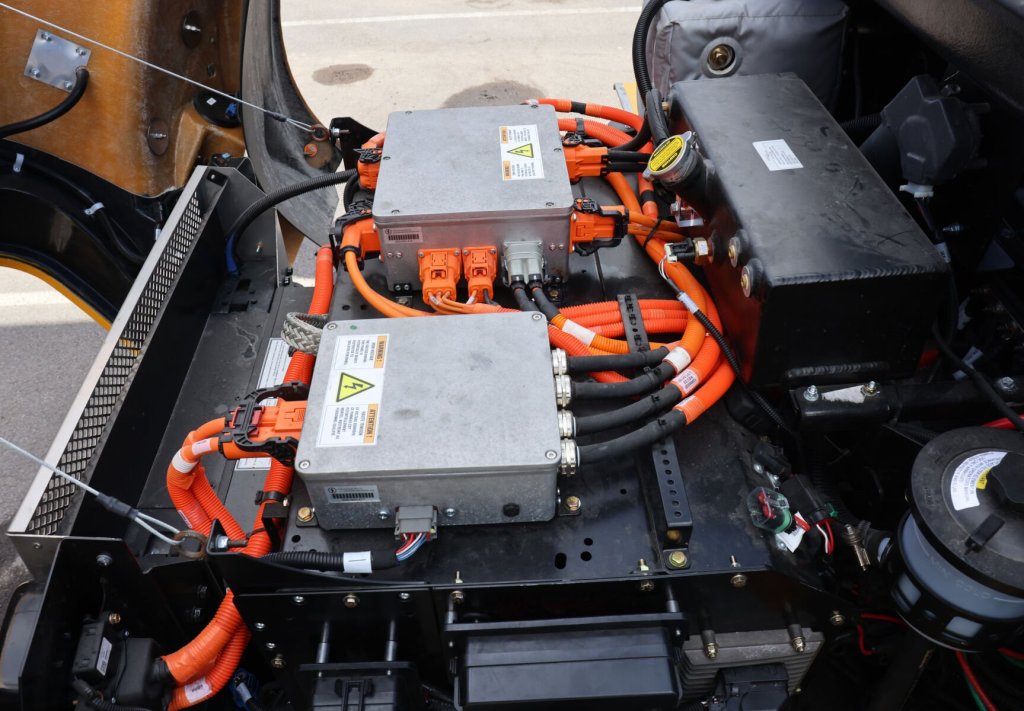First electric school bus east of Cascades starts making the rounds in Bend
Published 5:45 am Monday, March 6, 2023

- Under the hood are the electronic “brains” of Bend-La Pine School District's first electric school bus.
What sounds like an ice cream truck but brings kids to school in the morning? It may sound like a riddle but the answer is a reality — Bend’s first electric school bus.
The first of its kind east of the Cascades, the all-electric bus will hit the road starting this week to shuttle kids to class while also slashing greenhouse gas emissions.
Silver Rail Elementary School in Bend will be the first to utilize a new electric school bus, which plays a tune at slow speeds, but will eventually travel along other school routes, said Tina Bandy, assistant director of transportation for Bend-La Pine Schools.
The school district is one of several local agencies seeking ways to reduce their carbon footprint and combat climate change. The city of Bend has started transitioning to electric vehicles to replace its mainly gas-powered fleet of nearly 200 cars and pickup trucks. Bend Police Department is also utilizing around 30 hybrid vehicles.
“I think it’s the future of school buses. We have seen more and more electric vehicles in freight transport and heavy equipment. It’s the way we are going,” said Bandy, a former bus driver.
A half dozen or so electric buses are already in use in other Oregon school districts, including Beaverton, Newberg, and Salem-Kaizer. An additional 12 to 14 electric buses are on order for use around the state. According to Lion Electric of Quebec, Canada, which built the bus, using one bus is like taking five gas-powered vehicles off the road.
The use of electric school buses will help the community meet climate goals, said Cassie Lacy, senior management analyst for the city of Bend. It can also help raise environmental awareness among Bend’s youngest residents.
“The school district has such an amazing opportunity to engage with the younger generation,” Lacy said. “Their leadership can have a unique impact on youth that the city doesn’t reach as much.”
The electric-powered school bus will serve as a pilot project to determine how it handles Central Oregon’s climate, said Bandy. She believes the District will acquire more but adds that the bus yard needs an additional transformer before it can charge more buses.
More can be purchased if the first one is deemed a success, although improvements in energy capacity at the bus yard are also required.
“It would be a big infrastructure upgrade to bring on more buses,” Bandy said.
The total bill for the 71-seat bus, including the cost to deliver the bus to Oregon, was $383,240, said Scott Maben, a spokesman for Bend-La Pine Schools.
Combustion-powered school buses typically cost significantly less than an electric bus but over time those costs tend to even out because of fuel savings and lower maintenance costs. Maben says the District usually buys 78- to 84-passenger buses, which cost about $150,000.
Most of the cost of the Bend-La Pine bus was funded by a $157,500 grant from Pacific Power. The remaining $225,740 came from state resources administered by the Oregon Department of Energy.
The electric bus has a top speed of 60 mph and when fully charged has a range of up to 125 miles. Bandy said that’s enough to serve around 80% of the district’s bus routes. The electric bus can also be used on field trips locally, to the High Desert Museum, Redmond, and Sisters.
Because the bus operates in almost virtual silence, it plays a tune when it slows down to speeds 19 mph or less, alerting children to its approach. Bandy compared the tune to that of an ice cream truck.
“It’s so quiet, we have to let people know we are coming. That is the first thing that people will notice,” she said.
The bus takes eight hours to fully charge. The lower cost of electricity compared to diesel will reduce fuel costs for the school district.
Cold weather was a concern because the cold is known to drain lithium-ion batteries but the district received positive feedback from other school districts that have used the LionC bus in cold areas. “We were pretty confident that it would work here,” she said.
The bus has no tailpipe emissions, but it does emit some carbon on cold days because it uses a diesel system for its heating unit.
Carbon is also emitted indirectly because Pacific Power sources some of its energy from coal-fired power plants. But the district says electric school buses reduce greenhouse gas emissions by more than half compared to diesel school buses. Carbon monoxide and nitrogen oxide are reduced by 80%, the district said in a statement.
Neil Baunsgard, climate and transportation advocacy manager for The Environmental Center, said on a per-mile equivalent, the energy used by the bus will create 1.6 lbs of carbon dioxide compared to 3.3 lbs of carbon dioxide produced by a diesel-powered bus.
That reduction could help lower transportation-produced carbon coming from Bend, which accounts for 40% of all emissions, said Baunsgard.
“We are seeing more and more examples of climate change and global warming in our daily life here in Central Oregon,” he said. “The electric school bus is a good, tangible example of addressing those transportation emissions.”





